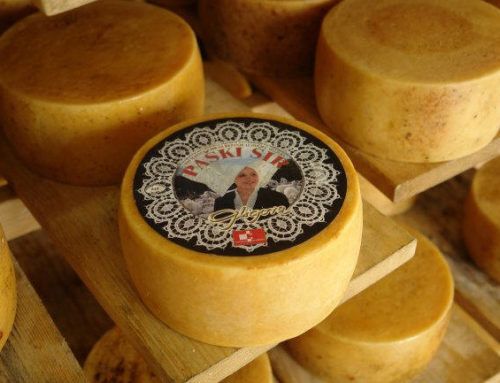The World According to Crème Brûlée
You may find my methods unconventional, but I can tell a lot about restaurants by the quality of the crème brûlée they serve—as it reveals more than one can imagine.
Let’s start with the color. Is it an insipid pale yellow or deep bright hue? All eggs have the genetic potential to be equal, but I’ve found that how the chickens are fed greatly impacts the finished egg and is most evident in the color of the yolk. Do this experiment yourself. Buy a dozen eggs from a small organic-egg and -chicken producer in your area and another dozen from the local supermarket. Crack a couple eggs from each carton together into a bowl. I guarantee you will see a marked difference between the yolks. The store-bought will be a much paler yellow and usually smaller, while the farmer’s eggs will be dark yellow and larger. Some farm-raised eggs have bright orange yolks. These are perfect for crème brûlée.
This difference comes from the diet. Though many egg cartons now claim their chickens are “free-ranged,” unfortunately it isn’t dependable labeling anymore. Some confinement egg producers leave a small door for the chickens to exit the confinement sheds, even if they never do. Some let them roam around inside big barns, where they never see a blade of grass. The new standard is “pasture-fed” eggs. The term usually means that in addition to receiving supplemental grains, the chickens are allowed to forage on pasture where they can incorporate wild plants and bugs rich in omega-3s into their diet.
While you might not find these best-quality eggs at the local supermarket anytime soon, organic food stores usually carry several kinds, and more and more restaurants are pioneering farm-to-restaurant connections with small egg producers. Patronize these restaurants and you will encounter the best crème brûlée. One of my favorite DC restaurants creates this timeless French classic with the bright-orange egg yolks from free-roaming chickens raised on Amish and Mennonite farms in Pennsylvania. It is something to emulate.
The next consideration is the quality of cream and milk and their proportions. Many a cheap restaurant will try to “milk down” its crème brûlée by cutting down on the amount of cream it uses. The ideal proportion is 3:1, i.e., 3 cups cream to 1 cup milk. Containing no starch for thickening, crème brûlée is by definition custard and not pudding, but recipes that alter the ratio of cream to milk end up being no more than glorified flan—and definitely not worth the high price. You will be able to discern this adulteration the moment your spoon cuts into the cream. By the way, never use UHT milk or cream.
Although you cannot expect restaurants to make crème brûlée with fresh raw milk and cream, I do it at home. Find a farm that will sell to you and treat yourself to an even higher grade of this wonderful dessert. I should mention that too few egg yolks can also contribute to a custardy end product instead of a creamy one.
Before you get to the crème, you must break through the bruléed sugar topping. Is it hard and crunchy? It should be and it will be if the crème was made far enough in advance and given the chance to cool properly. A cold crème helps the caramelized, molten sugar on top of the crème to cool quickly and become crunchy. If the crème is too warm, it cannot adequately cool the caramel. You will then find yourself trying to spoon through a messy topping that is not cooperating. To me, such a poor-quality crème brûlée is a sign of a disorganized kitchen—one that has not properly planned ahead to have enough of one of its patrons favorite desserts on hand.
Restaurants use industrial-size torches that are impractical for the home. Investing in a little handheld torchière that runs on butane gas is much preferable to trying to caramelize the sugar under a broiler. The chef, not the broiler, should be in charge of the subtleties that surround getting the best golden finish. And last but not least, use superfine sugar. It will make all the difference.
Finally, we get to the bottom of the crème. Did you find some tiny vanilla seeds there? You will if the crème brûlée is of superior quality. To get the best flavor, the vanilla bean must be steeped in the cream/milk mixture to become softer—so it can be opened easily with a knife and the seeds scooped out for addition to the cream/milk mixture. Only the cheapest restaurants would add vanilla extract instead of the whole bean. This fundamental error is reason to strike any restaurant from your list of favorites.
What is the perfect dish for crème brûlée? I use French-made ceramic Apilco No. 5 ceramic ramekins. There are many imitations. But again, the quality of the ramekin in a restaurant will tell you a lot about its kitchen practices and whether it values profits over quality.
Mother Linda’s Crème Brûlée
If you don’t skimp on the ingredients and bake ware, you will end up with the most incredible creamy dessert that tells your family and guests a lot of good things about your kitchen. Makes 8 servings.
- 3 cups fresh cream
- 1 cup fresh milk
- ½ cup sugar
- 1 whole vanilla bean
- 6 egg yolks
- 1-2 tsp. superfine sugar, per ramekin
In a heavy-bottomed saucepan on low, heat the cream, milk, and sugar. Stir the sugar to dissolve and then add the vanilla bean. Continue to heat until small bubbles appear around the edges, but do not allow it to boil. Remove from heat and cool for 10-15 minutes, while letting the vanilla bean soften.
Remove the vanilla bean from the cream, split open lengthwise with a sharp knife, and scrape the tiny seeds from the pod. Add the seeds to the cream, and discard the pod. Set a kettle on to boil some water.
Whisk the egg yolks into the cooled cream mixture, and then strain through a sieve to remove any unbeaten egg. Pour about ½ cup of the mixture into each of eight No. 5 Apilco ceramic ramekins. Set the ramekins in a deep-sided baking dish–or a crème brûlée kit like the one to the left. Pour enough boiling water into the baking dish or kit to come halfway up the sides of the ramekins. Bake at 325ºF for 50-60 minutes, or until a toothpick comes out clean.
Remove the baking dish from the oven, and let the ramekins cool. Transfer to the refrigerator and let the crème cool completely overnight, or for at least four hours.
Just before serving, remove the crème from the refrigerator and sprinkle the custard in each ramekin evenly with 1-2 tsp. superfine sugar. Using a handheld torchière, caramelize the sugar until golden brown. Let the ramekin set for a few minutes before serving so the sugar can cool and harden to perfection.
Do you have any crème brûlée insights? I would love to hear them.

